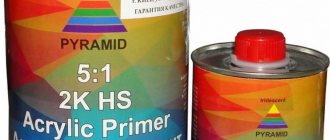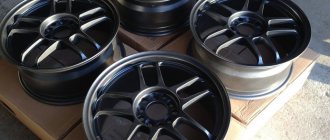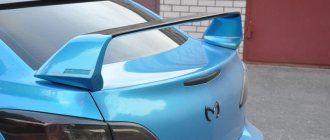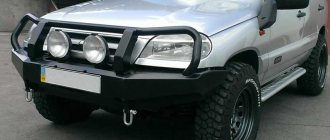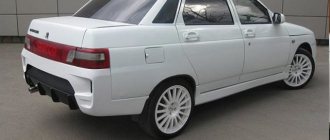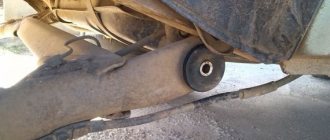Painting and polishing of a car is carried out only after high-quality preparation of the base. The metal surface requires careful cleaning, degreasing and puttying (if necessary). A key step in preparation is to degrease the surface to avoid deteriorating the paint-to-metal adhesion. It is important to know how to degrease a car body to achieve the best result. In this article we will look at which degreaser it is advisable to use and what are the features of working with it.
How to clean your car at home?
The degreasing procedure can be carried out in any room; no special equipment or skills are required from the user. Auto chemical stores offer a wide range of grease removers.
Car degreasers are conventionally divided into groups:
- organic compounds;
- synthetic substances;
- water-alkaline emulsions.
Degreaser "Nefras"
If we consider which degreaser is better in terms of versatility and availability, White Spirit definitely takes the leading position. Its main disadvantage is that this car degreaser leaves a persistent and strong kerosene smell. It will be extremely difficult to remove even with detergents. “White spirit” is made by distilling oil and, in terms of its chemical composition, is a composition of a number of liquid carbohydrates.
Any motorist can work independently with the substance. The product easily removes bitumen residues, various types of fats, and dirt from rubber and its derivatives from the car body. White spirit is especially effective against organic contaminants. But it will not be able to eliminate inorganic compounds containing oil.
If we consider the best way to degrease the surface of a car in order to remove inorganic substances, you should use a synthetic-based and emulsion-based degreaser. Both types of compositions are capable of eliminating pollution of any type and nature.
A synthetic car body degreaser should be selected taking into account:
- degree of adhesion with the primer, putty and paint layer;
- the ability of the agent to destroy compounds;
- the level of aggressiveness of the emulsion to the metal base of the machine.
At home, surface degreasing is often carried out using synthetic liquids “Nefras S 2-80/120”, “Solvent” and anti-silicone compounds, regardless of the manufacturer.
White spirit degreaser for cars
How to degrease?
This procedure can be performed with equal success both at home and at a service station. The second option is preferable if the vehicle is to be painted after cleaning.
There are two methods of degreasing.
- Non-contact – a cleaning agent is sprayed onto a dry car (BOS is most often used). After a few minutes, it will dissolve the plaque (this will be visible from the streaks on the body). After this, you need to cover the car with active foam and wash it off after a few minutes under pressure. It is worth noting that if there are large oily stains, the soaking process may take a little longer than a few minutes.
- Contact - apply a degreaser to a washed and dried car using a rag. Next, rub, using force on heavily contaminated areas. After this, apply active foam and rinse the car well under water pressure.
The cost of degreasing depends on the chosen product. The duration of the procedure at the service station will be 30-35 minutes.
We treat the car ourselves - how to avoid problems?
Degreasing a car body requires simple preliminary preparation and minimal protective equipment, such as:
- use of safety glasses. If it gets on the mucous membrane, the solvent dries the skin, causes irritation, and some aggressive compounds lead to burns;
- use of a respirator. The formula of "White spirit", emulsions and anti-silicones contains chemical compounds that can lead to a deterioration in health when inhaling vapors;
- use of rubber gloves to prevent negative effects on the skin of the hands.
2 non-woven napkins will help in working with the composition at the application stage. One is used to treat the car, and the second is used to remove any remaining degreaser, drops from the interior, and drips. The only condition is the absence of lint.
How to do degreasing yourself:
- soak a napkin with automotive degreaser;
- apply the composition to the body;
- With a second napkin, which was still dry, rub the product over the surface and remove defects.
You need to soak a napkin with car degreaser.
If the vehicle is degreased at a service station, the procedure will remain completely identical, since there is no need to use auxiliary equipment. After degreasing the metal, the quality of work is checked; the presence of grease is determined by touch or with a piece of paper. If traces remain, the body should be degreased again, but with a different composition.
Reasons for the appearance of defects on the car body
Scratches and chips on the paintwork of a car body are not always too obvious, but such damage can have an extremely negative impact on the condition of the vehicle, which is explained by the rapid development of corrosion areas on the metal.
Chips affect the varnish and base enamel down to the primer
The main reasons for the formation of chips on the car body are almost any external mechanical influences, which most often arise as a result of violations of parking rules or road accidents.
Defects in newly completed coatings arise as a result of:
- incorrect choice of paints and varnishes;
- poor-quality degreasing or application of paint on contaminants;
- lack of elimination of irregularities on the painted surface;
- violations in the technology of applying putty compounds;
- incorrect proportion of mixed materials;
- faulty compressor or spray gun.
Stones, branches and any other debris flying off from under the wheels of cars passing nearby can also damage the integrity of the body covering.
The faster you drive, and the shorter the distance from another vehicle, the greater the likelihood of chipping due to stones and other debris.
Degreasing car surfaces before painting
If you want to save money and carry out painting work manually, there is a need for independent degreasing. Correctly painting a car is only possible if you follow the basic technology and observe a number of subtleties of the process.
If polishing or painting is carried out, degreasing is a mandatory procedure, although it is not always obvious to amateurs. Painting over greasy metal will cause the top layer to peel off, causing the paint to crack and peel.
Out of standing
Salfeti Antibacterial. Wet Cleaning Wipes
Salfeti Antibacterial.
Wet cleansing wipes Price
~ 32 rubles Now everyone has cleansing wet wipes at hand. For example, antibacterial LLC Avangard from Tosno. There are 20 pieces in a package. The price of each is 1 ruble 60 kopecks. After processing, turn on the windshield washer for a short time - and enjoy the result. Instead of antibacterial wipes, you can use special car wipes (for cleaning glass or interior). True, they are more expensive. But for children, with glycerin and (or) castor oil, it is better to leave for another occasion.
Result:
This is one of the cheapest remedies, which is also very effective. One package is enough to treat the front of the car.
***
Of course, specialized tools coped with the task best: FILL inn and GRASS. As a backup option, if the professional formulations run out, I advise you to keep antibacterial wipes in the car. Well, if you run out of both, and the glass is again covered with midges, you can buy mineral water at the nearest store. And rub the glass a little more actively.
- Test of 11 drugs for removing tar, poplar buds and bitumen from the body - here.
How we will clean the windshield: 9 products (of which 6 are folk)
The procedure for carrying out repair work
Detailed algorithm for carrying out restoration work:
- Covering with masking tape areas and parts that should not be treated.
- Cleaning the paintwork at the damaged area.
Covering with masking tape areas and parts that should not be treated
- The straightening stage involves working with a hammer, spotter, drifts and other tools.
- Creating a perfectly smooth, clean and even surface using degreasing and priming. It is better to use the epoxy type of composition, since it does not allow air to pass through, inhibiting the oxidation process.
- Application of an insulating primer. Putty is difficult to apply to epoxy primer; low adhesion will lead to rapid destruction of the layer; you will have to use an insulating primer.
- Elimination of defects using putty.
- Repeated degreasing of the surface and application of an additional layer of primer.
- Coating with developing paint followed by stripping of the primer.
- Preparation for the painting stage: coating with degreaser, thinning the paint, gluing adjacent areas.
- Painting the body element.
- Varnish treatment.
- Final polishing of the paintwork.
The polishing layer is the logical conclusion of the entire procedure; it will help create the ideal appearance of the car.
In the presented algorithm, a car degreaser is used in 3 stages. The most important stage is the treatment before painting. If you ignore the recommendation, defects in the paint will soon appear - bubbles, peeling, shriveled areas.
Final polishing of paintwork
The most effective methods for eliminating chips on a car
Currently, several options are used through which you can quite easily and quickly eliminate defects in the paintwork of a car body yourself.
All these methods differ not only in the technology of independent execution, but also in the cost of consumables, preparatory measures and some other important parameters. Before you begin to repair chips, you must correctly determine the type of coating material, as well as the area of the damaged surface and the depth of the defect.
Before starting work, determine the location of all chips. They are usually located in the front of the car - near the headlights and radiator grille.
Brush and paints
Using special paint and brushes is one of the most common ways to deal with not too deep damage to the car body. Most often, the set of bottle with the coloring composition is supplemented with a plastic brush that does not absorb paint very actively.
In the store you can choose the paint of the desired shade
As practice shows, it is advisable to replace the included brush with a thin drawing brush based on natural bristles with a sharp tip. To eliminate small chips, you should purchase a bottle of tint, a degreaser and primer, varnish and a brush.
How to touch up defects on a car body yourself:
- Make a computer selection of paint shade.
- Clean the surface from dirt and degrease.
- Remove traces of rust with fine-grained abrasive.
- Prime defects that are too deep.
- Apply the coloring composition evenly with a brush.
- After a quarter of an hour, apply a second layer of material.
At the final stage, the previously thoroughly degreased and treated area of the chip is subjected to varnishing.
If there are several chips on the body, and you have no experience working with the chosen material, first try your hand at a less noticeable defect.
How to touch up defects with a spray can
Medium-sized defects in body paint are the most common, and to eliminate them yourself, you should purchase an aerosol can of acid primer with a total volume of 520 ml, as well as a can of basic automotive paint composition.
You need to use the can carefully so that the coloring is uniform.
Also, for high-quality repair of chips, you need to prepare acrylic primer or filler, a can of base enamel and car varnish, putty, rust converter, Scotch Brite, polishing pastes, a brush with stiff bristles and fine-grained sandpaper.
How to touch up defects on a car body yourself:
- Wash the car surface thoroughly with a regular detergent and wait until it dries.
- Remove all moldings, handles and other elements that interfere with the repair of chips, or cover them with tape.
- Remove old paint and primer in the damaged area with sandpaper.
- Apply rust converter to the cleaned area.
- Brush the surface with a stiff bristle brush.
- Reapply the converter, rinse with water and dry.
- Putty and sand all dents, and also remove any unevenness with sandpaper.
- Matte the areas around the chip with Scotch Brite.
- Degrease the surface and apply as even a layer of primer as possible.
- Wait until the primer dries and apply a second coat of primer.
- After the primed surface has completely dried, sand with sandpaper until a smooth base is obtained.
- Apply acrylic primer, which fills fine pores well and eliminates unevenness.
- Apply three coats of toner primer and let it dry in a color similar to the tone of the body coating.
Carrying out painting work involves heating a can of paint to body temperature, after which the paint is vigorously shaken and applied to the prepared chip surface using arcuate movements. After shading, apply 2-3 thin layers of car varnish.
Sometimes you come across cans of poor quality paint, so test it on another surface before applying it to your car.
Polish and anti-scratch
Car polishes do an excellent job with minor abrasions and scratches on the surface, up to medium sizes, as well as shallow chips on the body. Such compositions are used in manual and machine processing of surfaces, create a reliable protective layer based on polymers and wax, add shine to the car body, and are suitable for all types of paint and varnish coatings.
Why degrease the body before painting?
The paint is not able to penetrate through greasy substances and reach the metal base, therefore, in areas with poor-quality degreasing of the body, bulges or wrinkles appear.
Where does the fat on cars come from:
- natural human fat inevitably sticks to metal when touching the surface;
- residual traces from adhesive tape or appliqué;
- residues of a silicone-based spray or protective agent that is applied during polishing;
- bitumen and rubber stains;
- adhesion of burnt fuel and oil waste.
Repair and painting of the body is carried out exclusively after degreasing, since glue, film, paint, primer, putty and other products do not stick to fats.
Which car degreaser to buy?
When choosing a product for removing grease stains from a car body, focus on the following indicators:
1. Degreasing before painting
Do not forget that the procedure for cleaning each part of the car body from grease is carried out at all stages of paint and varnish work, namely: before puttying, priming and painting itself. And every time you need to follow the procedure exactly. Otherwise, “volcanoes” (swells) and wrinkling of the paintwork will appear on the surface of the car, and peeling of the primer or paint will occur (depending on which layer the degreaser is missing).
Reasons for the appearance of greasy spots or an oil layer on the car body:
As a rule, a special degreaser, anti-silicone, is used to clean the body. This is the most popular remedy, which is rightfully considered universal. It not only removes grease of technical origin, but also removes organic fingerprints that usually appear when processing a particular part. Thanks to anti-silicone, the surface is degreased, which allows for high adhesion.
There is one more remedy, no less useful than the previous one. This is the final degreaser for cars on a water-alcohol basis, which is used when painting the body. Such compositions remove sugar, salts, weak acids - everything that anti-silicone cannot do, but is necessarily present in water, traces of organic sweat or fat from the fingers. Sweat and water remain on the parts after they have been processed by a specialist. Therefore, it is better to add a water-alcohol type of degreasing to anti-silicones.
Drivers are wondering which degreasers are best to choose for car bodies? First of all, solutions packaged in metal cans. It is known that the plastic of a jar can dissolve and mix with the substance that is poured into it. This reduces the effectiveness of the mixture and changes its smell. It is useful to know that anti-silicones are divided into three types depending on the type of processing: for coarse, medium (fine) degreasing and plastic. Please check these details when purchasing a degreaser.
We recommend
In addition, grease removal solutions are distributed according to application (i.e. application phase), namely before painting, polishing or washing. For example, the Peresvet cleaning product, which is always on the shelves of car dealerships. It is perfect for treating the body before painting, but is not suitable as a degreaser for car washing or vehicle polishing. The reason for this is the aggressive composition of the solution, similar to Galosha (or Nefras) gasoline.
As for certain products that are preferred by craftsmen for performing body work, the best degreasers for cars are the following:
And don’t forget to read the instructions before purchasing to understand why the product is used and for which cars it is not suitable. As we mentioned above, chemical degreasers such as solvent 646, acetone and other aggressive compounds are prohibited for paintwork.
2. Degreasing before polishing
If you don’t want to paint or change the color of your car, but only plan to polish the body, you still can’t do without removing grease. We discussed the reasons for performing this procedure above. One thing is important: if you do not use a degreaser when polishing a car, the surface of the body will not be perfectly clean. This means that the polishing agents may soon peel off and the entire effect will be reduced to zero.
How to properly degrease a surface
Before degreasing the car body with your own hands, you should prepare the surface by removing the old paint and putty from it.
Degreasing the car surface
Rules for using a degreaser:
- Wipes for processing should not contain lint; such materials are sold in household chemical stores.
- You should choose a car body degreasing product that removes standard organic oil contaminants, as well as synthetic substances. The ability to remove sugar, salt and other specific substances present in water and harmful to the coloring result will be useful. Many specialists use hydroalcoholic Standox; it additionally removes beads of sweat that are resistant to anti-silicone.
- It is worth changing napkins during work, especially if the surface is dirty.
How to touch up chips depending on the location: bumper, roof, doors
Such a chip will require the use of P600 or P800 sanding paper.
Chips and small breaks or scratches on the paint surface of a car differ in depth, length and width, as well as location, so there are some nuances when touching up such body coating defects:
- damage may affect exclusively the top varnish layer or reach the metal, which affects the choice of repair tactics and means;
- if chips or scratches are located in the area of car doors or headlights, then before tinting the body, you should dismantle all elements or protect them with tape;
- exposure of the working surface to sunlight and warm air significantly accelerates the hardening of repair and restoration compounds, especially in the hood and roof areas, so work must be completed as quickly as possible;
- the damaged bumper is removed from the car, after which the paint is washed down to plastic or primer, and standard preparation of the part for painting is performed.
It should be noted that large and deep chips on the machine, regardless of location, will require the use of P600 and P800 sanding paper, which will smooth the edges of the damage and thoroughly clean the cavity.
Washing the Grease Remover Machine
The primary task of a painting specialist is to thoroughly clean the body using special detergents containing surfactants. The products easily remove various oils, fingerprints, traces of fuel and technical mixtures.
The next step is to use a car degreaser. White spirit and Nefras are mainly used; water-alcohol products have also proven themselves to be effective. Many paint and varnish manufacturers offer their own versions of degreasing solutions.
It is not recommended to use “volatile” solvents: acetone, NT, 646. They are extremely aggressive to the surface and can dissolve the substrate layer - paint, primer. Another negative side is the deterioration of adhesion and surface damage. The use of fuel (gasoline, kerosene, diesel fuel) to remove fats is not permitted, since they also contain fats.
The key task is to eliminate bitumen stains, stubborn silicone stains, beads of sweat, fingerprints and the like.
Washing the Grease Remover Machine
To avoid problems
It would seem that the degreasing process is a very simple process, but even here you need to be very careful; if you select the wrong grease removal solution, you can, completely unwittingly, damage the paintwork of your car. Therefore, the choice of liquid should be made as responsibly as possible and carefully read the instructions and recommendations of the manufacturers.
If the goal is to simply polish the car, then poorly done grease removal will not have fatal consequences. But if you make “mistakes” when preparing to paint the body, problems cannot be avoided. Almost 100% of the time you will have to redo everything from the very beginning, and this takes time and money.
We degrease efficiently and safely
The operation should not be difficult, since it is enough to moisten a cloth in a degreasing substance and rub the surface to be treated. An alternative method of application is a can with a spray nozzle and rubbing with a damp cloth.
The rags should not contain lint; use special non-woven napkins and paper towels made of thick material. The rags are changed regularly, since the grease needs to be removed and not spread over the surface of the body.
An important condition for degreasing is compliance with safety precautions: protection of eyes, skin, and respiratory system. Ventilation must be present and functioning in the room. You can do work outdoors. After the procedure, you must not touch the treated surface with clothing or hands, otherwise degreasing will have to be repeated.
Types of automotive degreasers
Today the market offers many products for degreasing cars. According to their composition they are:
To maximize the effect, use a degreaser for both types of cars. Acid-salt solutions work well with oxide films, but cannot remove fats.
Typically used in everyday life:
Car degreasers in the form of emulsions are ideal for removing complex contaminants. They combine the best qualities of aqueous-alkaline solutions and organic solvents. Concentrates containing inhibitors, additives, surfactants (for example, Docker, Dekamet, Chistomet) have a quick effect.
In addition to cleaning the surface of the car, such degreasers protect the body from traces of corrosion. The concentrated solution is diluted with water in different ratios, which determine the contamination of the part of the body that is to be painted.
If you do not find special products, use an alternative option - a car degreaser, which is available. In this case, you need to choose it taking into account the qualities of the surface being cleaned. If you have paintwork (especially old paint), primers and plastic, do not use solvents from the series 645–647, 650, etc. They are quite aggressive and can dissolve all of the listed materials. Do not use gasoline, solvent, diesel fuel, or kerosene.
We recommend
If you need a degreaser on bare metal, then solvents work well for this purpose. They will not corrode the iron surface. The same applies to acetone, which is prohibited for paintwork materials, but is allowed for metal parts of machine bodies. Chemical solvents are recommended for cleaning wood, pipes, profiles, metal structures, etc.
Can white spirit be used as a car body degreaser? Opinions vary on this issue, which is why it causes lively debate in technical circles.
Today, white spirit does not lose popularity among car service specialists. What properties attract craftsmen:
But still, at the preparatory stage before painting, it is better to abandon white spirit in order to prevent defects. It should be used for its intended purpose, and not as a degreaser for body repair. In addition, it is a solvent with a strong odor that takes a long time to evaporate and leaves an oily film.
We recommend
When treating your car before painting, you can do without harsh chemicals, using, for example, the sandblasting method of cleaning. Under high pressure, sand particles bombard the surface, removing grease and dirt.
Recommendations from experts when degreasing a car with your own hands
Experts note the ease of performing the procedure, but the importance of following basic rules:
- Degreasing is performed several times during the entire painting cycle. Initially, a solvent is used, then scratches on the car are removed, and then re-treated with a degreaser.
- Only specialized degreasers or safe solvents are used.
- If auto enamel for wheels is being processed, it is important to ensure the compatibility of the material and the degreaser. Disks are subject to numerous destructive influences, which is why they require additional protective coatings. The most reliable is powder coating of discs. If the combination is incorrect, unpredictable effects occur.
- It is recommended to perform all stages of preparation and staining in a special chamber. There are several ways to make a spray booth.
The procedure for removing fats and other complex contaminants is an important step towards creating a high-quality and durable paintwork. If you ignore this stage, wrinkling, spots with an uncharacteristic color, swelling and other defects will appear.
At the beginning of glorious deeds. Car wash
When a car comes in for repairs, the first thing to do is to thoroughly clean it of road dust, dirt and grease, and in winter also of salt and sand. To do this, wash the car thoroughly with warm water and car shampoo.
The best assistant in this matter is a high-pressure washer, such as a Karcher. This device allows you to effectively combat pollution due to strong water pressure (at low flow rates). It literally sweeps away dirt. For washing various hard-to-reach places, it is generally an irreplaceable thing.
Anyone who has washed a car with a Karcher knows that it is a complete pleasure.
